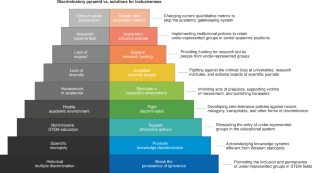Science is still an enterprise in which positions of power are mainly held by white, cis-gender, male academics. We discuss how the legacy of science’s exclusionary past still persists in scientific structures and propose concrete changes to open the system to a more diverse future.
This is a preview of subscription content, access via your institution
Relevant articles
Open Access articles citing this article.
-
Community voices: sowing, germinating, flourishing as strategies to support inclusion in STEM
Nature Communications Open Access 09 June 2022
-
Community voices: the importance of diverse networks in academic mentoring
Nature Communications Open Access 25 March 2022
-
The Gender Gap in Brazilian Entomology: an Analysis of the Academic Scenario
Neotropical Entomology Open Access 12 November 2021
Access options
Access Nature and 54 other Nature Portfolio journals
Get Nature+, our best-value online-access subscription
$29.99 / 30 days
cancel any time
Subscribe to this journal
Receive 12 digital issues and online access to articles
$119.00 per year
only $9.92 per issue
Buy this article
- Purchase on Springer Link
- Instant access to full article PDF
Prices may be subject to local taxes which are calculated during checkout

References
Barder, A. D. Third World Q. 40, 207–223 (2019).
Mills, C. W. in Race and Epistemologies of Ignorance (eds Sullivan, S. & Tuana, N.) 11–38 (SUNY Press, 2007).
Turney, S. et al. Science 369, 1171–1172 (2020).
García-Holgado, A., Díaz, A. C. & García-Peñalvo, F. J. Engaging women into STEM in Latin America: W-STEM project. in Proc. 7th Internatl Conf. Technological Ecosystems for Enhancing Multiculturality 232–239 (ACM, 2019).
Pinheiro, B. C. S. @Descolonizando_Saberes: Mulheres Negras nas Ciências. (Editora Livraria da Física, 2020).
Hofstra, B. et al. Proc. Natl Acad. Sci. USA 117, 9284–9291 (2020).
Leite, L. & Diele-Viegas, L. M. Nature 587, 163–164 (2020).
Jaremka, L. M. et al. Perspect. Psychol. Sci. 15, 519–543 (2020).
Astegiano, J., Sebastián-González, E. & de Toledo Castanho, C. R. Soc. Open Sci. 6, 181566 (2019).
Stoet, G. & Geary, D. C. Psychol. Sci. 29, 581–593 (2018).
Acknowledgements
We thank L. P. Salles, B. Pascal, R. Santos-Silva, C. Birrer, and A. Campos for their comments and insights during the discussion that gave rise to this manuscript. This study was partially financed by the Coordenação de Aperfeiçoamento de Pessoal de Nível Superior - Brasil (Capes) - Finance Code 001.
Author information
Authors and Affiliations
Contributions
L.M.D.-V. and L.L. were responsible for the conceptualization of the ideas. L.M.D.-V., T.C., T.E., J.H., C.Q.S., E.S., A.C.V., and L.L. were equally responsible for the validation and writing of the manuscript. L.M.D.-V. was responsible for the graphic visualization, supervision, and project administration.
Corresponding author
Ethics declarations
Competing interests
The authors declare no competing interests.
Rights and permissions
About this article
Cite this article
Diele-Viegas, L.M., Cordeiro, T.E.F., Emmerich, T. et al. Potential solutions for discrimination in STEM. Nat Hum Behav 5, 672–674 (2021). https://doi.org/10.1038/s41562-021-01104-w
Published:
Issue Date:
DOI: https://doi.org/10.1038/s41562-021-01104-w
This article is cited by
-
End bullying and harassment in academia
Nature Human Behaviour (2022)
-
Stop using anecdotal evidence in conversations about gender
Nature (2022)
-
Community voices: the importance of diverse networks in academic mentoring
Nature Communications (2022)
-
Community voices: sowing, germinating, flourishing as strategies to support inclusion in STEM
Nature Communications (2022)
-
Brazilian budget cuts further threaten gender equality in research
Nature Ecology & Evolution (2021)
